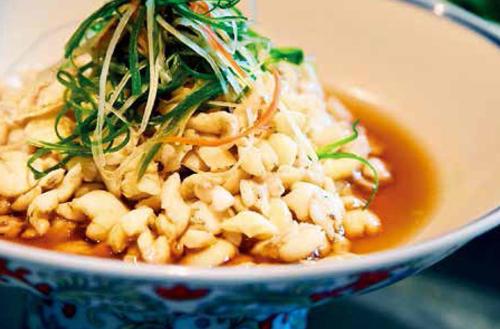春来一盘“荤豆瓣”
柏建斌



春夏之交,土步鱼鱼肥质嫩,肉白如银,较之豆腐,有其嫩而远胜其鲜。
江南的村庄,小河小塘就在屋前屋后。
河塘最大的特色便是那些大大小小的石埠頭,这种埠头十分简陋,一些石块随意堆砌而成,深深浅浅,全由河水涨落而定。
立夏前后的一个清晨,湖州一带的村妇照例来到河塘边,埠头上便热闹起来。
而此时水中同样热闹的,是在石穴间匍匐穿梭的鱼儿,被村妇叫做荡匍。
“今天鱼多,轻点声,帮着多抓几条,我家男人最喜欢的下酒菜。”一位大嫂边笑,边拿起竹篮在石缝那儿一舀,一两条黑色小鱼儿进了篮子。
“荡匍”是湖州长兴一带的叫法,杭州人叫它土步鱼。此鱼又名沙鳢(lǐ),属鱼纲塘鳢科,江苏人直称之为塘鳢鱼。
在杭嘉湖一带有关这种鱼的做法最出名的有两种,一是“步鱼春笋”,再就是“荡匍蒸蛋”。
做这两道菜用10来尾鱼着实是够了。炒春笋一般用整条,而蒸蛋,则用鱼身上取下的嫩肉。
但如果说要化腐朽为神奇,做到唯美,那就是我要说的这一道“荤豆瓣”了。
奢侈的“荤豆瓣”
也不知道是哪位厨子的异想天开,他发现这条黑色小鱼双颊上的腮帮肉非常特别,这地方的肉是鱼呼吸时活动最频繁的部分,鲜嫩而筋道。而取下这块半月芽形的腮帮肉,像极了小粒的豆瓣,于是,奢侈无比的一道菜便出现了。
有史料为证。宋代文献《玉食批》描述“土步辣羹”时讲道:一小碗,耗鱼108尾,得“豆”216粒。此菜做法无从查考,但取豆瓣之法,似乎也算是“效法天地,比拟乾坤,法于阴阳,合于数术”了。
“如果家中做此菜算是奢侈了,要耗费那么多的鱼,但在餐馆却算不得什么,毕竟这鱼头本来就没什么用。”最近专注此菜的晓明师傅说,如果炒着吃或者红烧,鱼头太小一般没人在意,而此时腮帮里的豆瓣也老了,失去了鲜嫩劲,“但真要做成‘荤豆瓣却不那么容易。”
先把鱼头一个个剪下,蒸至半熟,然后用竹签等小心翼翼地把腮帮子拨开,挑出完完整整的一粒半月芽形“豆瓣”肉来。
“要盛一盘上桌,那真得100多条的土步鱼儿。”取好之后的做法和火候十分要紧,一边把油烧沸,一边把‘荤豆瓣出水后装盘加辅料,之后沸油一淋即成。
当然,食用时间也有要求:快。因为取“豆”不易,一般上桌前是分而食之。
细看这一小碗,一粒粒的“豆瓣”晶莹松软,藏于葱丝之间更显活泼。油淋后的半汤呈栗红,高级感油然而生。
取几粒尒汤一起送入口中,首先感觉到的是鲜,其次是Q弹,这“豆瓣”毕竟不同于豆腐,用牙齿轻咬的感觉非常Q弹,有弹牙之感。
“豆瓣”很容易咬开而不会塞牙,除了鲜味更增加了口腔的满足感。
历代美食家点赞土步鱼
每年的这个时候,美食家沈宏非最记挂的便是这道“荤豆瓣”了,他曾在朋友圈写下感受:“豆瓣”得之不易,食之更不可大意,盖因其乃塘鳢全身至嫩至滑之肉,入口后不及细嚼慢咽,很容易一不小心从唇舌之间直接滑落至咽喉而令人掷匙浩叹。
描述得非常有趣。
把那么难得的腮帮肉比喻成“豆瓣”,算是一种智慧,也是最为低调的奢华了。沈宏非还讲了一个典故,说当年上海“海派川菜”创始人何其坤师傅(曾经是老锦江饭店和张爱玲在小说里津津乐道的“蜀腴”川菜社总厨)在为宋庆龄做家宴时,曾献上一道上海本地人饭桌上最低贱的“咸菜豆瓣汤”:汤里的咸菜是雪里蕻,这其中的“豆瓣”就是这土步鱼的腮帮肉。
《随园食单》也曾记载,杭州以土步鱼为上品。肉最松嫩。煎之,煮之,蒸之俱可。加腌芥作汤,作羹尤鲜。
春夏之交,土步鱼鱼肥质嫩,肉白如银,较之豆腐,有其嫩而远胜其鲜。
西湖里的土步鱼更是出名。白居易离开杭州时曾写诗道:“未能抛得杭州去,一半勾留是此湖。”诗人留恋西湖的晴好雨奇之外,应该还有湖中味美可口的鱼鲜。清代诗人陈璨曾有一首《西湖竹枝词》来诠释白公勾留的一部分内容:“清明土步鱼初美,重九团脐蟹正肥,莫怪白公拋不得,便论食品也忘归。”清代王端履曾有竹枝词里也曾写道:“竹篱轻傍渔舟插,要买新鲜杜父鱼。”而据民国《萧山县志稿》载:“出湘湖者为最,桃花水涨时尤美。”
“瓦盆重叠漾清波,赚得潜鳞杜父名。几日桃花春水涨,满村听唤卖鱼声。”这是说从前“滨湖之家以瓦为阱或用破舟沉水中,隔宿起视则鱼已穴处焉”,似乎与村妇用竹篮舀鱼同法,这里杜父当为土步鱼吧。
遗憾的是,从20世纪60年代起,由于种种原因,土步鱼的产量已大为减少。
两道江浙家常菜
“步鱼炖蛋”是长兴当地一种最常见的吃法,将步鱼肉的鲜嫩特质发挥得淋漓尽致。
将洗净的步鱼和蛋液盛放在一个瓷盆中,放入少量的盐,然后架在饭锅的水米之上,和米一道接受锅下烈火的考验。饭熟之时,也是这道菜成就之时,焖几分钟后揭开锅,在蛋上加上葱末,淋上酱油,倒上一些刚刚沸腾的菜籽油,就是一道完美的步鱼炖蛋。制作就是这么简单,但是味道却不一般,鸡蛋的香味沁入鱼肉之中,入口便是满嘴的鲜香。
“春笋步鱼”是杭州名菜,可以说是山珍之鲜与湖珍之美的珠联璧合,作为春令美食老少咸宜。与春笋为伍,也决定了这道菜品尝时间的短暂,必须珍惜。 (本文图片由视范摄影提供)
Dark Sleeper: Springtime Delicacy in Jiangnan
By Bai Jianbin
Dark sleeper (Odontobutis obscurus) is a springtime delicacy in Jiangnan, a traditional name for the south of the Yangtze River Delta. The small-sized fish can be easily caught in rivers and ponds in Jiangnan. Usually, it is cooked in two ways: it is cooked with springtime bamboo shoots; and it is steamed with eggs. About ten dark sleepers would be enough for a dish. Fish bones and heads must be removed if dark sleepers are to be steamed with eggs. Most family kitchens would choose these two ways to enjoy dark sleeper in springtime.
Dark sleeper can be cooked into a luxury called “meat-like broad beans”. Few families would bother to do the luxury, simply because the dish needs a tiny part from hundreds of dark sleepers. The ingredient has nothing to do with broad beans, however. The ingredient is a tiny bit of half-moon flesh from inside the fish head. As one fish contributes only two half-moon bits, at least 100 dark sleepers are needed to get an adequate amount of “broad beans”. A heap of the tiny flesh bits from the heads of dark sleepers does look like broad beans in a bowl or on a plate.
A book written in the Song Dynasty (960-1279) mentions a soup made of 216 “broad beans” from 108 dark sleepers. “It is too much a luxury for a family kitchen. But a restaurant can do it easily. After all, the heads of dark sleepers are almost useless,” remarks a modern chef, who knows how to prepare such a dish of half-moon bits from dark sleepers. He first scissors off the heads from dark sleepers, steams the heads to a half done degree, and then pick the “broad bean” bits out of the gill space inside the fish head with a slender bamboo pick. “It needs over 100 dark sleepers to have a full dish of fish ‘beans,” says the chef.
The fish “beans” are then quick-boiled. They are ladled out of boiling water and placed into a small bowl. After seasonings are added to the fish “broad beans”, hot oil is poured onto them. The dish is ready.
The delicate taste of dark sleepers is highly appreciated by gourmets. Shen Hongfei (born in 1962), a contemporary gourmet, food writer and documentary producer, once wrote about the dark sleeper “beans”. “The ‘broad beans are not easy to come by. Eating them could be a challenging job. You need to carefully put them into your mouth and chew them carefully and thoroughly to get the full taste. If you are not careful, the smooth and slippery ‘beans could fast sneak down into your throat and then into your stomach. That would be a waste of time and delicacy.”
According to Shen, the dark sleeper “beans” and pickled vegetable soup was once served at an important banquet. The rare fish flesh from dark sleepers was simply called “broad beans”. A look at the menu would not reveal what they really were. The delicacy is also mentioned in the written in 1792 by Yuan Mei, a poet and gourmet of the Qing Dynasty (1644-1911).
Dark sleepers taste best in springtime. Unfortunately, dark sleepers are not as many as they once were in Jiangnan due to the disappearance of some of fishs breeding grounds since the 1960s.

